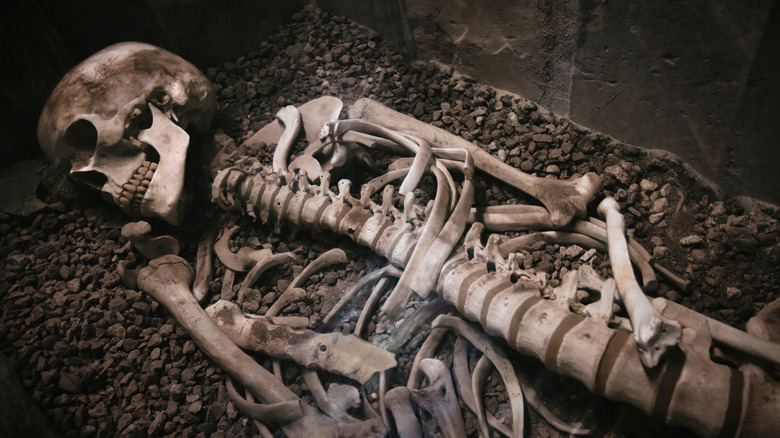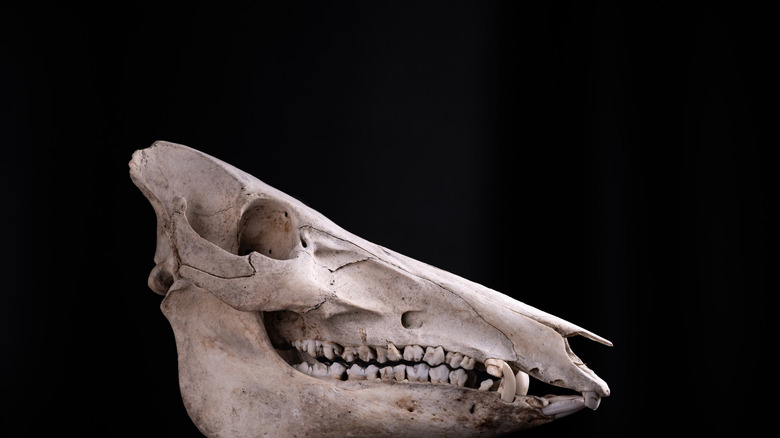What Happens To A Body When It's Encased In Concrete?
Almost immediately after death, the body starts to decompose. After the heart stops beating and the organs shut down, the muscles begin to stiffen during rigor mortis. Then autolysis sets in, breaking the cells down with the body's own enzymes. The next stage of the decomposition process is the bloating of the body, caused by bacteria in the intestines that produce a foul-smelling gas. This stage — and the remainder of the process that ends in skeletonization — is slowed down when the body is sealed in a coffin, especially if it has been embalmed.
Overall, it takes approximately 10 to 15 years for a body to fully decompose inside a coffin. According to Nicholas Passalacqua, an associate professor at the Forensic Osteology Research Station at Western Carolina University., the decomposition process takes around five years for bodies that aren't buried (per Live Science). But what about a body that's sealed in concrete? Trapped in such an airtight environment, would the process be delayed even longer — or perhaps cease altogether? While there is a limited amount of evidence that exists on the subject, what we do know is that concrete might preserve a dead body — somewhat.
Pigs in a concrete blanket
Though it's not a commonly studied subject, there are at least two recorded experiments showing the effects of concrete on the decomposition process — both using pigs in place of humans. One is a 2013 American Journal of Forensic Medicine and Pathology study. It involved the burial of four piglet corpses (that died of natural causes) in cement to examine the postmortem macroscopic and microscopic effects. Over the course of six months, the concrete block in which the carcasses were buried was opened for analysis of the piglets.
After the first month, the bodies had begun to putrefy, and the legs were partially skeletonized. At two months, skeletonization had advanced, as well as significant putrefaction of the back and abdomen. Between the third and six months, the bodies became mostly mummified with signs of adipocere — a greasy postmortem tissue also known as grave wax that forms under specific oxygen-less conditions. As a result, researchers concluded that "microscopic changes may be delayed in concrete."
In a 2020 Biology experiment, a dismembered pig was buried in a similar fashion to that of a human man who had been murdered, dismembered, and buried in concrete. The experiment was conducted for two purposes: To test the ability of radiological technology to locate remains buried in cement, and to analyze the effects of a concrete-encased body on decomposition. Measuring the decomposition rate over the course of a year, researchers found that by the end of the experiment, the head of the pig showed advanced signs of decomposition, while its leg was still in the early stages. So essentially, both of the studies proved that pig bodies encased in concrete are certainly not immune to decay.
Human bodies encased in concrete will inevitably decompose
So, pig bodies decompose in concrete. Does the same go for human bodies? While there are no records of similar studies that use human corpses instead of pig corpses to analyze decomposition, there have been numerous cases of human bodies found buried in concrete — usually under homicidal circumstances.
An article published on Forensic Science International reported six cases of human bodies entombed in concrete and/or sealed behind brick. In each instance, the deceased were victims of homicide, their bodies hidden by their murderers. Case 2 in the report involved the remains of a 31-year-old woman found in a cellar that had been wrapped in a foil shroud and encased in a brick trough filled with concrete. The report declared that the "putrefaction smell was noticeable" in the cellar, indicating evidence of the body's decomposition before it was dug up for an autopsy. Case 6 in the report detailed the findings of a 53-year-old woman entombed in a deep cave in her garden that had been filled with concrete, including a graphic picture of her putrefied remains.
The article concluded that in all six cases, the concrete-encased bodies were wrapped in different materials, reporting that "the cadavers were conserved in a definite stage of putrefaction" and adding that, "setting corpses in concrete and/or sealing with bricks does not prevent smell." Of course, a picture is worth a thousand words, and images of such remains depict plenty of signs of bodily decomposition, even when buried in a concrete tomb.


